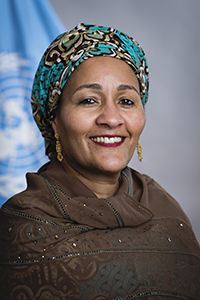Amina J. Mohammed is UN Deputy Secretary-General who addressed the General Assembly’s Annual AIDS Review meeting.
UNITED NATIONS, Jun 2 2017 (IPS) – During the process of developing the Sustainable Development Goals it was clear to me how relevant and innovative the approach to ending AIDS had been and how important it would continue to be.

Amina J. Mohammed
Achieving our aims on AIDS is interlinked and embedded within the broader 2030 Agenda. Both are grounded in equity, human rights and a promise to leave no one behind.
In June 2016, Member States adopted the Political Declaration on Ending AIDS. As the Secretary-General’s report notes, the AIDS pandemic is far from over.
UNAIDS estimates that more than 36.7 million people are living with HIV globally.
While more than 18 million are now on life-saving treatment, this is just half of those who need it, and there is no decline in the number of new infections each year.
People living with HIV who are on treatment can now expect the same life expectancy as someone who is not infected.
That is why a life-cycle approach to HIV is so important, to ensure that people have access to the services they need at every stage of life.
The world has the scientific knowledge and experience to reach people with HIV options tailored to the realities of their lives.
I am happy to report that, today, more babies than ever are being born free from HIV.
Now we need to do a better job of reaching young women and adolescent girls.
This is particularly true for sub-Saharan Africa, where adolescent girls account for three out of four new HIV infections among 15 to 19-year-olds.
Women’s and girls’ heightened vulnerability to HIV is intimately linked to entrenched gender-based inequalities and harmful social attitudes.
We also need to ensure a more integrated approach to HIV programme delivery.
In particular, we need to integrate HIV, sexual and reproductive health programmes, including family planning.
Just as we must reach young women, we have to make it easier for other key populations to access health services.
Injecting drug users, sex workers, and men who have sex with men are 10-24 times more likely to acquire HIV than the general population. Ending AIDS fits squarely within the 2030 Agenda.
The global commitments we have made to eliminate gender inequalities, to promote, protect, respect and fulfil all human rights, and to achieve universal health coverage, mutually reinforce efforts to eradicate AIDS.
The AIDS response has led the way for evidence-based policy and programming. I hope the voluntary national reviews at the High Level Political Forum in July will reflect the lessons learned at the national level in responding to AIDS.
I urge Member States to heed UNAIDS’ call for a grand prevention coalition that stimulates action across the five pillars of HIV prevention. We still need a further $7 billion dollars to reach our targets for preventing and treating HIV.
This translates to about 50 cents per person per year globally between now and 2030. This small per capita increase in investment could generate significant returns an additional 21.7 million HIV infections prevented and 8.8 million AIDS-related deaths averted.
The economic benefits of such an intervention would generate an 8 to 1 return on investment due to better health and reduced mortality.
I am proud to see how the United Nations and UNAIDS, under the leadership of its Executive Director, Mr. Michel Sidibé, are committed to finding new and better approaches to end this epidemic.
I hope to see our investment in ending the AIDS epidemic and saving lives translate into political and financial investment in UNAIDS. This entity embodies many of the critical elements that we are seeking to incorporate into our broader UN reform efforts.
These include establishing a culture of accountability and strong performance management, with a focus on delivery rather than process and on people rather than bureaucracy.
In conclusion, let me emphasize the importance of grounding success at the country and community levels.
Let us always approach political decisions and meetings such as this with communities in mind.
In recognizing the importance of community-driven solutions and the global commitment to people-centred systems for health, I encourage you to listen closely to what communities need and have to say.
If we do that, we can end AIDS.